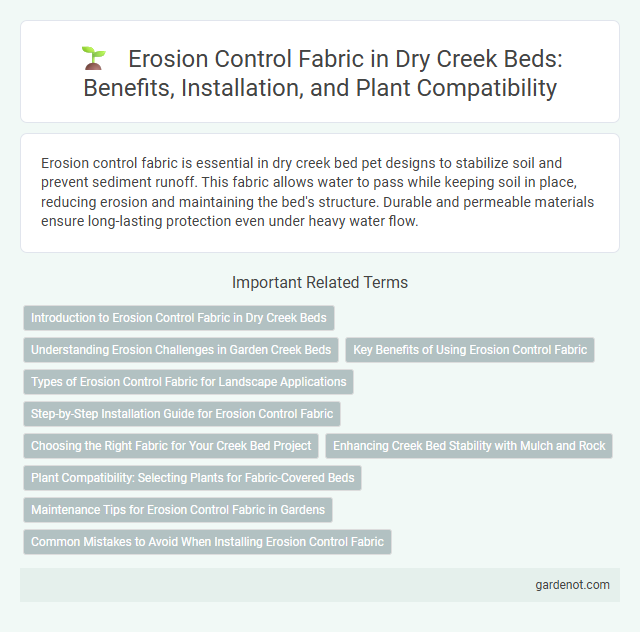Erosion control fabric is essential in dry creek bed pet designs to stabilize soil and prevent sediment runoff. This fabric allows water to pass while keeping soil in place, reducing erosion and maintaining the bed's structure. Durable and permeable materials ensure long-lasting protection even under heavy water flow.
Introduction to Erosion Control Fabric in Dry Creek Beds
Erosion control fabric in dry creek beds acts as a protective layer that stabilizes soil and prevents sediment displacement during heavy rainfall or water flow events. Made from biodegradable or synthetic materials, these fabrics enhance vegetation growth by retaining moisture while reducing surface erosion. Proper installation of erosion control fabric promotes water filtration and maintains the natural structure of dry creek beds, supporting ecosystem health and preventing costly land degradation.
Understanding Erosion Challenges in Garden Creek Beds
Erosion control fabric plays a critical role in stabilizing garden creek beds by preventing soil displacement caused by water runoff and heavy rainfall. This specialized material enhances soil retention while allowing water to permeate, reducing the risk of sediment loss and maintaining the natural flow of the creek. Implementing erosion control fabric effectively addresses challenges such as soil degradation, bank instability, and vegetation loss in dry creek bed landscapes.
Key Benefits of Using Erosion Control Fabric
Erosion control fabric stabilizes soil in dry creek beds by reducing surface runoff and preventing sediment displacement, enhancing long-term landscape durability. Its permeable structure allows water infiltration while inhibiting weed growth, promoting healthier vegetation establishment along creek margins. This eco-friendly material minimizes maintenance costs and supports sustainable erosion management in vulnerable riparian zones.
Types of Erosion Control Fabric for Landscape Applications
Erosion control fabric for dry creek beds primarily includes woven, non-woven, and biodegradable types, each designed to stabilize soil and prevent erosion effectively. Woven fabrics offer high tensile strength and durability for long-term projects, while non-woven fabrics provide superior moisture permeability and sediment filtration. Biodegradable options, often made from natural fibers like jute or coir, promote vegetation growth by decomposing over time, enhancing natural landscape restoration.
Step-by-Step Installation Guide for Erosion Control Fabric
Begin by clearing the dry creek bed of debris and leveling the surface to ensure proper fabric placement. Cut the erosion control fabric to fit the contours of the creek bed, then anchor it securely with landscape staples spaced at least every 3 feet along the edges and seams. Overlap adjacent pieces by 6 to 12 inches to prevent soil infiltration and promote effective erosion control throughout the area.
Choosing the Right Fabric for Your Creek Bed Project
Selecting the appropriate erosion control fabric for your dry creek bed project depends on factors such as soil type, water flow intensity, and vegetation presence. Synthetic fabrics like polypropylene offer durability and resistance to high water velocity, while biodegradable options promote natural vegetation growth and soil stabilization over time. Proper fabric selection ensures effective erosion prevention, enhances creek bed stability, and supports long-term environmental sustainability.
Enhancing Creek Bed Stability with Mulch and Rock
Erosion control fabric significantly enhances creek bed stability by preventing soil displacement while allowing water permeability. Combining this fabric with mulch and strategically placed rock creates a protective barrier that reduces surface runoff and minimizes erosion. This integrated approach supports vegetation growth and maintains the natural flow of the dry creek bed.
Plant Compatibility: Selecting Plants for Fabric-Covered Beds
Erosion control fabric in dry creek beds enhances soil stability while requiring plant selections compatible with fabric properties. Native drought-tolerant species such as sedges, grasses, and groundcovers with fibrous root systems promote soil anchoring through fabric mesh without hindering water infiltration. Choosing plants with moderate growth rates and root structures that penetrate fabric openings ensures effective erosion control and sustainable vegetation establishment.
Maintenance Tips for Erosion Control Fabric in Gardens
Regular inspection of erosion control fabric in dry creek beds helps identify tears or displacement early, preventing soil erosion. Keeping surrounding vegetation trimmed reduces debris accumulation on the fabric, ensuring proper water flow and filtration. Applying mulch over the fabric enhances protection against UV damage and supports moisture retention for optimal erosion control performance.
Common Mistakes to Avoid When Installing Erosion Control Fabric
Incorrect overlapping of erosion control fabric seams allows water to bypass and undermine soil stability, increasing erosion risk in dry creek beds. Failure to anchor the fabric properly with stakes or pins can cause it to shift or lift during heavy flow, compromising its protective function. Neglecting to remove sharp debris before installation may puncture the fabric, reducing its effectiveness in preventing soil displacement.
Erosion control fabric Infographic

 gardenot.com
gardenot.com